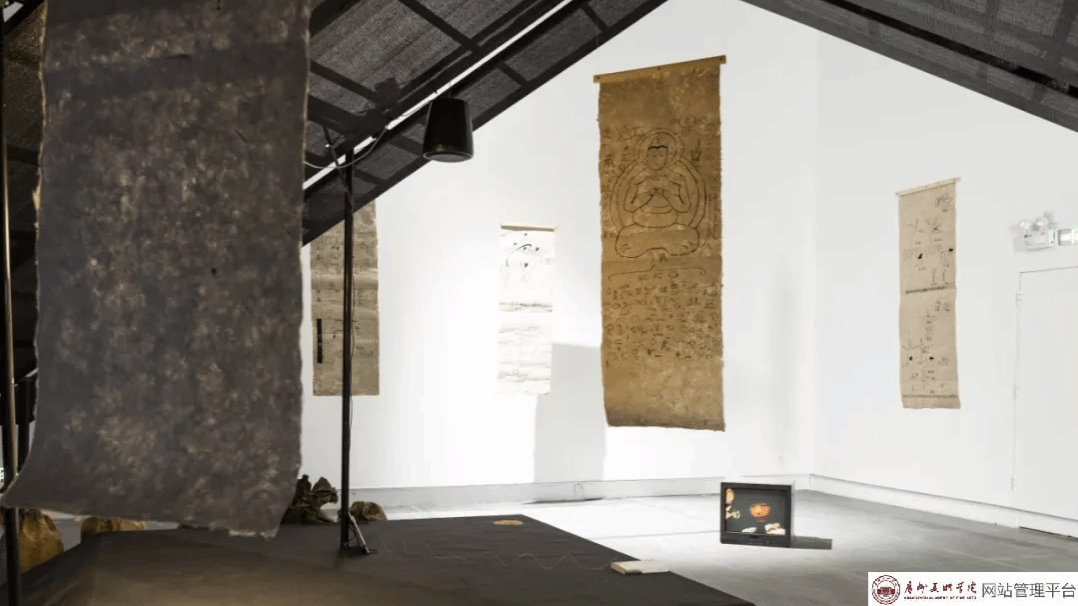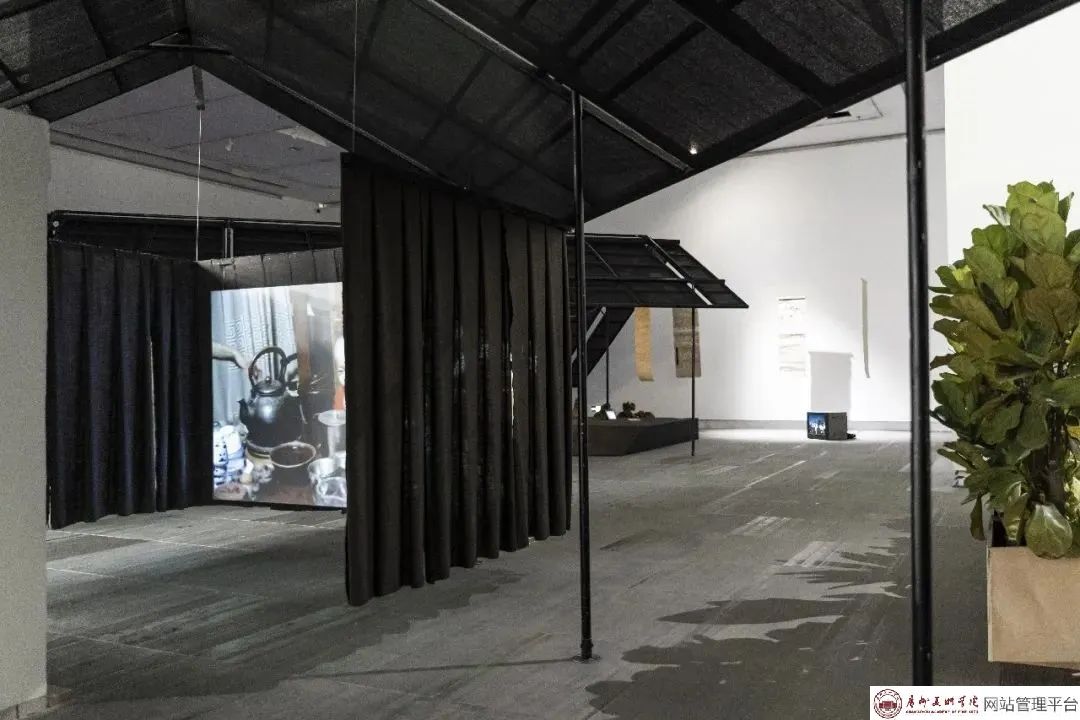
“我们的目光——艺术、人类学与亚洲映像” 展览现场
广州美术学院大学城美术馆,2025年 ©广州美术学院美术馆
展览“我们的目光——艺术、人类学与亚洲映像”虽已落幕,但其引发的思考仍在延展。本文集整合了四篇发表自《中国社会科学报》的深度述评,其作者均为“我们的目光——艺术、人类学与亚洲映像”展览的策展人与艺术家,他们从主创者的内部视角出发,深入梳理该展览实践背后的学理脉络与创作逻辑。本次汇编转载,旨在原展览的基础上,进一步呈现展览团队内部的思考脉络与学术关怀,为探讨人类学与艺术的专题研究和策展提供更为发散与多维的注脚。
01多模态的整体性:人类学民族志新视野
2025-07-22
作者:鲍江(中国社会科学院社会文化人类学研究中心研究员)
来源:中国社会科学网-中国社会科学报
人类学以长时段田野民族志研究见长。人类学民族志有三种主流模态,即文本、文物和影片。它们的研究进路各异,各自自成一体。新近有学者提出多模态人类学概念,指向多种模态的聚合,在人类学界引起广泛反响。
民族志源于人类学,肇始于1851年出版的美国学者摩尔根的《易洛魁联盟》,特指人类学家在有别于自己成长背景的人群中从事长时段的田野工作,通过与本地人合作获得对对象人群和自己的深入认识,然后创作表达此认识,最后与社会分享自己的作品以实现其专业使命。自20世纪七八十年代以来,民族志逐渐被其他学科借鉴,变成一种常规的人文与社会科学研究方法,其对象领域已超越民族范畴,扩展到对乡村、工厂、医院、街区、学校、科学实验室等具体场域的长时段田野研究。
人类学民族志在其开创之初即切割为两种模态——文本和文物。民族志文本以学者作品的形式呈现,包括调查报告、期刊文章、专著等,通过出版社实现社会交流。民族志文物以文化展品的形式呈现,包括各种文化专题展,通过人类学、民族学博物馆实现社会交流。民族志知识生产流程包含三个环节,即田野工作、民族志制作和民族志公开发表。一般而言,民族志文本强调民族志知识生产三个环节的生产者同一性,以此纯化它的第一手知识性质。民族志文物则属于博物馆为第一推动力的知识生产,田野工作者可能兼任文物收集者和文物目录撰写者的角色,但展览的第一责任人则另有其人——专业策展人。
19世纪末电影摄影机诞生,人类学逐渐将它纳入自己的田野工作工具箱,并于20世纪50年代正式奠定了自己的电影模态——民族志电影。后来,在此基础上又发展出影视人类学、影像民族志等新概念。民族志电影主要通过民族志电影展实现社会交流。与民族志文本类似,民族志电影强调民族志知识生产三个环节的生产者同一性,强调田野工作、影片制作和影片作者的生产者同一性。20世纪末以来,数字音像技术逐渐普及,人类学的电影模态步入高速发展轨道,学术界逐渐厘清了民族志文本与民族志电影两种模态的关系。文字人类学与影视人类学本体论分杈,民族志电影不复制民族志文本,它们有各自独立的田野研究进路,和而不同地完善人类学知识生产。
数字技术推动学术思想解放和学术创新,多模态人类学有望把民族志田野研究带到一个新的整体性地平线。《美国人类学家》2017年第1期刊发的《多模态人类学》一文,第一次提出多模态人类学这个概念。文章认为,影视人类学面临三大生态变化:其一,媒体生产的(相对)民主化和整体化;其二,人类学研究转向担当和合作;其三,人类学家的活跃角色面对专业和他们的田野社区。这些变化提出一个新的框架,即多模态人类学,不仅通过多媒体工作,而且通过一个联系不同媒体平台的场域,介入公共人类学和合作人类学。
多模态文化记录在中国源远流长,譬如“图经”体例,“图”与“经”(文本)结合,可以追溯到《山海经》。21世纪以来,多模态学术实践日趋活跃。“中国节日志”课题由文化和旅游部中国民族民间文艺发展中心规划实施,由文本和影像两部分组成。影像部分题名为“中国节日影像志”,旨在以影片模态记录中国各民族、各地区的传统节日。该项目自2010年底开始实施,目前已进行200余个子课题的立项拍摄。“中国节日影像志”的项目队伍由150余个课题组2000多名来自全国各高等院校、科研院所、传媒机构的人员组成,项目组成员涵盖民族学、人类学、民俗学、影视艺术等多种专业。此外,一些学术交流平台也为影片模态的民族志田野研究以及研究成果的社会分享提供了基础支持。
近年来,庄孔韶团队发表耕耘多年的“绘画人类学”理论与实践成果、朱晓阳团队以戏剧模态呈现学术史研究的成果《魁阁时代》,在学界反响热烈。笔者的多模态民族志专著《娲皇宫志:探索一种人类学写文化体裁》,尝试以个案研究探索传统志学与人类学的融合,涉及文本和影片两种模态。近期以展览形式发表的“多模态多感官民族志展——我的俄亚纳西族田野工作”则是一件涉及更多模态的民族志作品,包括以下六个部分。展览空间设计模态部分,突出俄亚纳西族宇宙观重视垂直轴的特征;文本模态部分,陈列一本纸质民族志专著《象征的来历:叶青村纳西族东巴教仪式研究》(2008),供观众翻阅;影片模态部分,循环放映两部电子版民族志影片《新年好》(2008)和《俄亚东巴初访广州》(2024);文物模态部分,从俄亚当地人那里租借了九只由当地人手工制作的牛皮口袋,并购买了俄亚当地产的谷子,包括小麦、大麦和玉米,把它们装入牛皮口袋中,供观众观看、触摸、嗅闻;装置模态部分,在俄亚定制了五张由当地人手工制作的东巴纸,加工成悬轴画,上面绘制从《象征的来历:叶青村纳西族东巴教仪式研究》里摘录的插图,以视觉冲击力刺激观众的文化想象力;礼物模态部分,准备了赠给观众的小袋装的俄亚当地产的小麦、大麦和玉米。
总之,每一种模态都有其不可替代的文化记录与呈现价值,多模态民族志整合同一人类学家关于同一田野的多种模态的民族志研究成果,旨在以相比单一模态更为饱满的整体形式和内容兑现人类学家把自己的长期田野工作经验带给社会以增进人与人联结的学术使命。
【编辑:刘翔英(报纸) 齐泽垚(网络)】

扫码查看原文网址
02在“错位”中“造物”:从文本、影像到艺术装置
2025-07-22
作者:张静红(南方科技大学社会科学中心副教授 )
来源:中国社会科学网-中国社会科学报
影视人类学者常常面临“错位”的感觉。这种感觉首先来自文本的挑战。人类学迄今为止仍然以文本创作为正宗,忙于影像制作的影视人类学家有时会惶恐于自己是否正在“不务正业”。“错位”在拍摄过程中也非常明显。影视人类学家特别是观察式电影的实践者,奉行一边拍摄一边探索的原则;影片结果的开放性,既令人期待又容易使人迷失。笔者尝试进一步探究的则是另一种“错位”,即影视人类学家遭遇艺术装置时所面临的机遇和挑战。虽然同样使用影像作为重要的创作语言,艺术装置却要求影视人类学家以重新组装的方式使用影像,并思考影像如何与装置中的物件协调共振、联合表达。
基于长期以来在书写和影像双重道路上的耕耘,以及近期参与艺术装置实践的经历,笔者深感文本、影像和装置的创作代表着不同的思维方式。先来比较文本和影像。以一个村庄为例,文本民族志的功能和长处是解释性的、结构性的,可以将这个地方的来龙去脉、前世今生娓娓道来。而一部关于村庄的影像民族志,特别是依靠蒙太奇镜头本身而非幕后解说词来叙事的影片,其优势则在于影像独有的感染性,比如,生动呈现村庄某次仪式活动里的人物形象、环境氛围。如果有观众认为影片也要交待清楚村庄的人口数字、族群来源,那么他或她显然还被规训在文本的诉求里,还没有意识到影像不同于文本的功能和特性。在保罗·亨利看来,文本重在“告知”,影像则重在“展现”。“告知”意味着对事物意涵的一种锁定,“展现”则意味着将意涵一定程度地开放给受众去理解。
许多感官和感觉体验难于以文字来形容,在“感官转向”的研究趋向影响下,影视人类学者尝试通过感官电影凸显某些声音和画面效果,以此间接激发观众去了解和想象多种感官和感觉的存在。笔者以空调为主题的研究项目,最初的设计是以感官电影的方式展现人们使用空调的复杂感受和社会经历。空调在视觉景观、听觉干扰、气味改变、身体感受等方面都大有文章可做。炎炎夏日,空调带来的远不止凉爽和惬意,更有人们使用中的经济考量、身体焦虑、人群区隔等元素。在一座原来气候宜人的小城市,空调使用的剧增与移民、旅游、房地产、传统村落变迁等都密切相关。那么,一部感官影像民族志如何言说这许多复杂的事物?
正在欲剪还乱之际,笔者参加了一次人类学者与艺术家的对谈及合作实践。在影像与艺术装置相结合的工作里,每位作者的成果都可以是“多模态”的,即除了影像,还包含实物、艺术装置,可以兼顾对多种感官和感觉的营造与呈现。虽然“多模态”是成果的标签,但受到艺术家和组织者的启发,笔者逐渐意识到,要把自己关于空调的研究与艺术装置相结合,要做的其实不是加法,而是减法。就像不该用文本的方式去要求影像一样,现在要忌讳的则是用常规影像民族志的方式去设计艺术装置。
首先,与艺术装置并置的影像,其时长相对较短,力求在较短的时间内让观众抓到要点。这对于习惯了做长片的影视人类学家来说,意味着编辑思路和方法的调整。其次,与装置对话的影像要配合周遭的装置、物件来共同表达,即影像只是“多模态”的一个部分。如何在影像和其他装置、物件之间形成共振,是设计的关键。人类学家的田野往往与“物”紧密相关,但什么样的“物”可以成为与艺术装置相嵌的一部分,这面临许多现实困难。而且,艺术装置的“物”不一定直接来自田野收集,而可以是配合主题新创的、具有一定抽象意义的“物”。人类学家擅长于分析“物”,但要自己动手来“造物”时,却倍感压力。
不过,人类学家至少要提供关于“物”的点子,因为成果可以由人类学家与组织者甚至艺术家共同合作完成。人类学家手里的“法宝”是田野积累,那么如何在繁杂的事物中通过减法挑选出最具代表性的“物”?在对谈交流中,该活动的组织者、广州美术学院陈晓阳一语道破,艺术重在灵动,找到最恰当的一个点和角度,就能设计出打动人心和点破主题的作品。在此启发下,相比于文本和影像,笔者将艺术装置的思维方式概括为“激发式的”,它不求面面俱到,但力求如禅宗顿悟般直指人心。
于是,笔者在业已收集到的有关空调的种种信息之中,找出一个关键的“物”——房子。在报告人的叙述中,传统的杆栏式民居正因为内部材料的变化而不得不使用空调;人们住进现代楼房与挂起空调是同步的;房地产的发展最为直接的影响是居住方式。组织者和笔者经过沟通,认为可以设计一个特殊的凳子,这个凳子应长得像楼房,里面可以吹出冷热风。观众坐在这个凳子上,感受温度变化的同时,观看一段由笔者制作的名为《空调与城市》的影像。虽然在后来的实践中,这个设计因为材料和安全等因素的限制而有所调整,但其设计思路与思维方式令笔者受益,为未来将自己的人类学研究与公众联结,开启了一扇窗。
这种“错位”,呼应着当下人类学与其他多学科不断碰撞,产生新思想、新领域和新方法的态势,也正是人类学这门学科能够在发展中保持生命力的重要体现。
【编辑:刘翔英(报纸) 齐泽垚(网络)】

扫码查看原文网址
03媒介化、当代艺术展与视觉人类学
2025-07-22
作者:熊迅(中山大学新闻传播学院教授 )
来源:中国社会科学网-中国社会科学报
传统的人类学研究往往要“走出去”,到传统的村落社会或者遥远的他者世界进行田野调查,去观察、体验和感知对象世界的知识,并把这种知识和经验带回到自身所在的世界中进行阐释。当下的人类学研究同样关注现代生活和自身世界的变迁。我们看到,媒介化正在融入甚至重构日常生活世界。“媒介化”意味着媒介如同水、电、路一样,正在成为社会的基础设施——媒介不只是信息传递或沟通的技术,还渗透和嵌入到社会生活之中,成为形塑社会的重要构件。媒介化意味着影像不仅是一种表达工具,而是影响、介入、重构着知识、关系、文化与社会。在此意义上,视觉人类学既持续关注作为媒介的民族志影像如何深描和阐释文化,也关心以视觉为中心的媒介化过程如何在社会中运行和流通,以及如何融入社会生活与意义之网的建构中。
通过接续、反思、拓展古典艺术和现代艺术的脉络,当代艺术逐渐成为一个兼容并蓄的整体,涵盖行为、实验、装置、观念等纷繁复杂的新形式,也包括在新媒介重构下的传统艺术及其衍生形态。媒介化对当代艺术的影响主要体现在两个方面:一是新媒介、新载体、新符号相关的艺术实践,催生了新的艺术形式与艺术语言;二是媒介变迁背后艺术价值的变化,对艺术家、作品与受众的关系,甚至是对艺术哲学也产生了诸多影响。许多当代艺术作品不仅聚焦美感经验,而且综合制造直击人心的情感互动,追问生命本质和艺术意旨,强调艺术家和观众共同参与到艺术体验和意义建构中。
正是在媒介化和人类学边界拓展的视野下,当代艺术与人类学之间开始出现新的交汇与合作趋势。一方面是艺术的人类学转向——艺术家采用人类学的方法进行田野调查并进行创作;或者关注“他者”和他者相关的艺术表达,运用主客位交织的转换来拓展作品的深度。另一方面,人类学的文化表述也在持续进行,建立在田野洞察和伦理观照的基础上,突破传统“写文化”的单一模态,持续用绘画、影像、装置、图像、行动等方式,深度参与到阐释对象世界和拓宽知识边界的互动探索中。双重取向的进路中,视觉人类学具有连接感知经验、抽象理论和文化阐释的学科潜能,既关注视觉的记录性与表现力,也研究多模态的知识生成机制。如民族志电影往往以低干预拍摄、多角度叙事、语图文结合等手法,保留田野中的鲜活细节,使观众得以感知“在场”,并通过有效的信息结构来达到文化阐释、影像深描和沉浸式理解。
视觉人类学要真正“超越民族志电影”进行拓展,还需要在三个层面进行持续性的实践和创造性的突破:其一,超越以文字为中心的“写文化”范式,发展出准确且有效的多模态语言和互动叙事方法。如哈佛感官人类学实验室在十余年来所进行的具身性和感官性的影像实验,或者加拿大国家电影局的系列互动式和参与式社区共建项目等。其二,从“深描”出发,走向构建影像实践与文化场域间更深层次的互文或共振,使人类学成为文化变迁、社会关系、认同建构的参与者甚至推动者。如文化和旅游部的“中国节日影像志”“中国史诗影像志”、国家图书馆的“中国记忆”项目等,既进行文化深描,又促进文化传承,还建构家国情怀。其三,多模态影像不应仅被视作静态文本,更应作为生成地方性知识、激发社会行动的媒介机制介入其中。如庄孔韶通过系列艺术实验,以论著、诗学、绘画、记录、表演、策展等表征实践来建构主客一体的意义世界;南加州大学在南美雅诺玛莫人聚居地长期的研究实践在公共领域引发的人类学伦理反思等。
在媒介化时代,视觉人类学与当代艺术的交汇不仅是方法与媒介的互用,更是一种共同介入社会变迁的文化实践。随着媒介技术深度嵌入日常生活,社会知识的学习方式与传播路径正在发生深刻变化。视觉人类学与当代艺术的融合,或许可以通过跨界合作来感知相互的知识结构与社会身份,共同开启一种回应现实变动并能进入公共领域的新表达。当然,一个前置条件也应充分讨论和实践,即人类学知识哪些部分更具“文化共振”的潜力和可能?文化中的视觉性是否被充分认识和挖掘?地方性知识的可展示性为何?更进一步,在既有社会框架中,人类学理论和知识的公共性应该如何持续被推动?
总之,视觉人类学带着自身的主体性和局限性介入媒介化社会,其研究旨趣、知识关系与文化位置与当代艺术的感官实验和表达策略相互审视与振动,从而有可能建构起融合学科边界、生成开放经验的知识共创和价值共生的当代场域。
*本文系国家社科基金项目“媒介化视阈下少数民族社交媒体应用与中华民族共有精神家园建构研究”(23BXW106)阶段性成果
【编辑:刘翔英(报纸) 齐泽垚(网络)】

扫码查看原文网址
04多模态人类学与参与式美术馆策展
2025-07-22
作者:陈晓阳(广州美术学院美术馆馆长、教授 )
来源:中国社会科学网-中国社会科学报
进入21世纪以来,越来越多公共美术馆出现在中国的城市生活中,成为非正式教育空间。史蒂芬·威尔从博物馆与公众角度强调博物馆的未来要从以“物”为中心转向以“人”为中心,这场“博物馆革命”同样影响到作为艺术博物馆的美术馆,观众从此不再只是被动地接受审美熏陶,而是可以参与到对作品的阐释和理解中来。此外,随着当代艺术的出现,很多艺术家选择舍弃叙事性和表现性的造型审美诉求,转向以多媒介艺术语言呈现对个体、社会及历史问题思辨和批判性反思。美术馆通过特定专题的研究和策展,也成为社会思想和文化研究成果交流的临时“集结地”。
美术馆里的临时知识社区
新博物馆学运动起源于20世纪六七十年代的社会运动和社区倡议,强调博物馆的社会角色、文化功能以及与观众、社区、社会的互动,随着20世纪80年代《魁北克宣言》的发布,逐渐演变为影响深远的世界性运动。其基本理念与原则强调跨学科方法与合作,关注社区与社群,倡导和鼓励观众及社区居民的介入和参与,注重在地性与国际化之间的联系与探索。与以长期固定陈列为主体的博物馆相比,以策划临时展览见长的美术馆成为更灵活并充满实验性的开放场域。美术馆可以选择围绕藏品进行研究,探究作品及其背后的历史、社会与人的变迁,通过策展视角和线索在展厅中创造时空通道,帮助观众重返历史语境中展开与今天相关议题的思考;也可以选择有共同问题意识的艺术作品,通过艺术家对具体生活和情境的观察,创造性地记录与有感而发地呈现,搭建对话场域,让复杂或被忽略的感官体验及社会问题显形。此外,美术馆在展览期间还会对展出作品中某些特殊元素或物质性材料进行进一步开发,为特定人群设计相应的公共教育项目,通过多模态、多感官的方式,包括声音、触摸、身体律动、剧场、创作过程体验等方式传播作品中蕴含的观点和理念,将更接近具身体验的整体知识和信息传播给观众。
多模态人类学与作为“平等媒介”的影像
自20世纪90年代以来,伴随全球经济一体化所带来的科技和产业的迅速扩张,录像艺术在全球范围内迅速发展,逐渐成为全球当代艺术的重要类型。与此同时,人类学界也发展出专业从事民族志电影制作的学者和学术共同体,人类学家开始关注与文字、语言相异的“视觉性”信息,如人类学影像对于身体和感官多模态经验的表达,成为民族志研究和写作之外的有效补充。人类学作品的感官转向,使其具备了走出学术象牙塔的可能,甚至来到更具公共性的美术馆空间与更广泛的读者和公众进行对话。
随着网络技术和移动设备的全球普及,影像愈发显现出作为“平等媒介”的可能,大多数人都拥有了记录和展现影像的技术,通过镜头的“看与被看”也演变为权力与话语的博弈和较量。不但有人类学家尝试通过“影像赋权”给田野伙伴,帮助他们自我表达,当代艺术家也借助民族志视角转向走入地方和现场的文化深处进行观察,从视而未见处着手,寻找文化表达的新路径。在广州美术学院美术馆近期举办的“我们的目光——艺术、人类学与亚洲映像”展览中,美术馆成为多模态人类学知识分享和传播的新公共场域。通过12位人类学家和艺术家在田野及现场所创作的影像,呈现出相对刻板的亚洲叙事中一些以往未曾顾及的微观故事或个体声音。与文本民族志不同,这些结合不同情境艺术装置的影像作品和跨学科讨论,呈现在面向所有公众开放的美术馆展厅中,人类学的知识传播就出现了更有具身感的交流,很多被科学语言和文字过滤掉的田野信息,也以多感官的形式浮现出来。
参与式策展与主客合作
此次展览的参与性实践不止包括展览期间为观众策划的体验式工作坊,还包括前期策展过程的策展人与人类学家、艺术家的线上参与式对话,人类学家与田野伙伴共同制作展品,以及田野伙伴来到展览所在的城市和美术馆与观众直接对话。展厅中除了以亚洲南部常见的“热带坡屋顶”构成象征性聚落来烘托田野感,并不过多强调艺术家与人类学家作品的分别。这种对学科边界的有意模糊和对专业中心主义的降解,是希望在去掉知识标签后,以影像作品为核心构建多维感官现场。展览围绕影像作品建立起空间、视觉、声场、气味和触感的多感官叙事,呈现为亚洲南方的山海、岛屿、雨林、港口、社区、村落和其间人群“映像”的对照与交叠。在展场的中间地带,还呈现了参与式策展过程中不同学科和领域对于各自工作的误读、对话和理解过程,也为观众在展场内留下对话和继续回复开放性问题的卷轴,这种多向度的开放和互动,让“参与”的可能性得到极大扩展。这种灵活与兼容的策展方式和多模态表达,不但以行动回应展览标题中“我们”的意义所在,也提醒了依赖模糊与多义的“我们”概念的风险。从这个意义上来说,美术馆也成了学术思想传播与社会实践的多元公共空间,成为多模态人类学的实验传播场域。
【编辑:刘翔英(报纸) 齐泽垚(网络)】

扫码查看原文网址

“我们的目光——艺术、人类学与亚洲映像” 展览现场
广州美术学院大学城美术馆,2025年 ©广州美术学院美术馆


